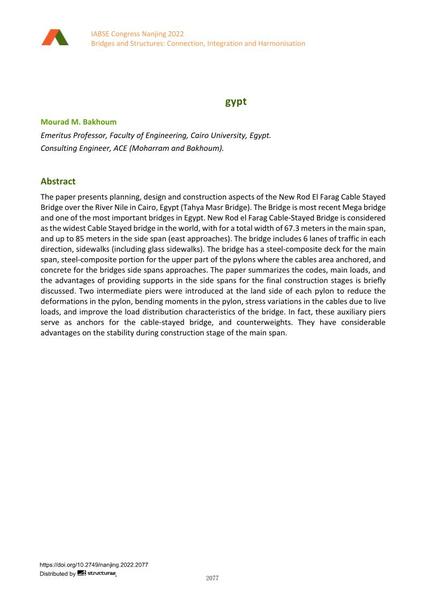Planning, Design and Construction Aspects of Rod El Farag Cable-Stayed Bridge over River Nile, Cairo, Egypt

|
|
|||||||||
Détails bibliographiques
| Auteur(s): |
Mourad M. Bakhoum
(Emeritus Professor, Faculty of Engineering, Cairo University, Egypt; Consulting Engineer, ACE (Moharram and Bakhoum))
|
||||
|---|---|---|---|---|---|
| Médium: | papier de conférence | ||||
| Langue(s): | anglais | ||||
| Conférence: | IABSE Congress: Bridges and Structures: Connection, Integration and Harmonisation, Nanjing, People's Republic of China, 21-23 September 2022 | ||||
| Publié dans: | IABSE Congress Nanjing 2022 | ||||
|
|||||
| Page(s): | 2077 | ||||
| Nombre total de pages (du PDF): | 1 | ||||
| DOI: | 10.2749/nanjing.2022.2077 | ||||
| Abstrait: |
The paper presents planning, design and construction aspects of the New Rod El Farag Cable Stayed Bridge over the River Nile in Cairo, Egypt (Tahya Masr Bridge). The Bridge is most recent Mega bridge and one of the most important bridges in Egypt. New Rod el Farag Cable-Stayed Bridge is considered as the widest Cable Stayed bridge in the world, with for a total width of 67.3 meters in the main span, and up to 85 meters in the side span (east approaches). The bridge includes 6 lanes of traffic in each direction, sidewalks (including glass sidewalks). The bridge has a steel-composite deck for the main span, steel-composite portion for the upper part of the pylons where the cables area anchored, and concrete for the bridges side spans approaches. The paper summarizes the codes, main loads, and the advantages of providing supports in the side spans for the final construction stages is briefly discussed. Two intermediate piers were introduced at the land side of each pylon to reduce the deformations in the pylon, bending moments in the pylon, stress variations in the cables due to live loads, and improve the load distribution characteristics of the bridge. In fact, these auxiliary piers serve as anchors for the cable-stayed bridge, and counterweights. They have considerable advantages on the stability during construction stage of the main span. |
||||
